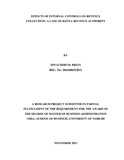| dc.description.abstract | The Kenya Revenue Authority was formed at a time when revenue collection was very low and the need to expand the tax base was necessary. KRA then embarked on an ambitious project of reviewing its operations and coming up with internal control mechanisms to enhance revenue collection. The objective of this study therefore was to closely look at the internal controls in operation at Kenya Revenue Authority with a view to establish whether such internal controls have produced any meaningful results in increased collected revenue. The research was conducted using both qualitative and quantitative approaches. Questionnaires were used on a population of 38 respondents in gathering primary data for the study. The data collected was then analyzed and findings have revealed that the five components of control environment, risk assessment, control activities, information and communication and monitoring must be available for internal controls to work. The study established that weak internal controls have encouraged collusion to fraud, loss of revenue and embezzlement of collected revenue. The study therefore concludes that internal controls do function although with hiccups and that there is a significant effect between internal controls and revenue collection in KRA. | en |

